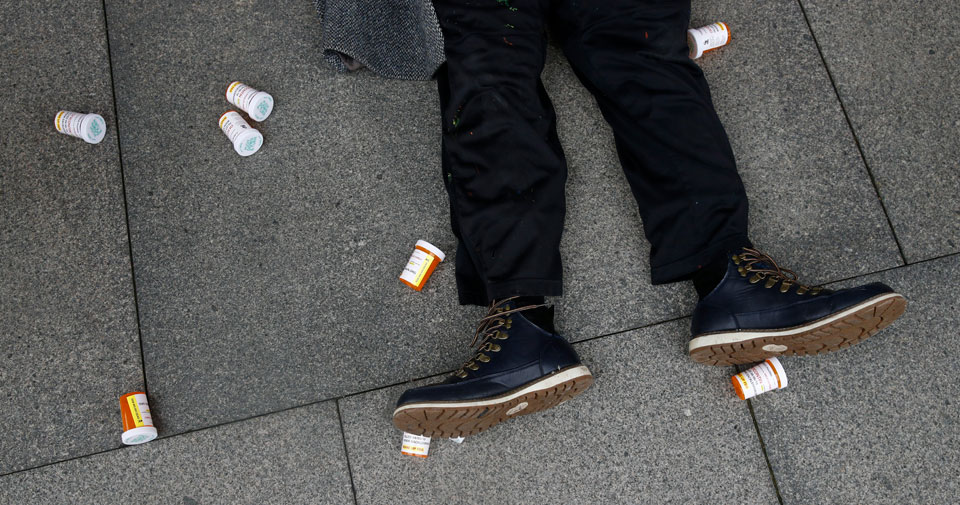
This article is the first of a two-part series on the opioid crisis gripping the nation.
“What we do have in Cleveland County (Oklahoma) is 135 prescription opioids for every adult,” state’s attorney Brad Beckworth told a judge. “Those didn’t get here from drug cartels. They got here from one cartel: the pharmaceutical industry cartel. And the kingpin of it all is Johnson & Johnson.”
This is how Beckworth described one of the largest global drug manufacturers in an Oklahoma courtroom, where the drug company stands accused of fueling the nation’s opioid addiction crisis.
Since 1996, opioid overdoses have caused over 200,000 deaths. The drugs are a class of painkiller drugs derived from opium, also the source of morphine, heroin, and cocaine. Fentanyl, which is one of the most widely used pain medications and one of the Johnson & Johnson products under scrutiny at the trial, is a synthetic opioid.
Blinded by greed, Johnson & Johnson—and dozens of other drug manufacturers, distributors, pharmacies, and doctor—turned their eyes away from the opioid crisis swamping the country. Meanwhile, the Drug Enforcement Agency (DEA) tracked the spread of opioids but did little to stop it.

In the wake of this crisis, families are mourning the loss of loved ones, millions are addicted, communities devastated, including some of the most poverty-stricken areas of the country, and public hospitals and health clinics overwhelmed.
In the rural town of Norton, Va., the death rate is 18 times the national average. “Our jails are overflowing, a high percentage of children now have to be raised by their grandparents, and our court system and emergency services are strained,” said Mayor Joseph Fawbush.
While government entities at every level are left footing the bill to address the health and social crisis, the pharmaceutical companies attempt to shift the blame to Mexican drug lords, overzealous doctors, and the victims themselves.
Roots of the current crisis
Over 2,000 state, city, county, and tribal governments have brought a “landmark” consolidated lawsuit against some of the largest pharma manufacturers, distributors, chain pharmacies, and doctors. The trial is set to begin in Cleveland in October.
The lawsuits, brought under the RICO (Racketeer Influenced and Corrupt Organizations) statute designed to prosecute organized crime, contend the drug manufacturers knew the opioids were addictive and ineffective despite their claims to the contrary and created a public health crisis.
The Washington Post and Charleston Gazette filed suit last year to unseal company documents along with a DEA database that tracked opioid sales. Despite fierce opposition by the companies and the DEA, the U.S. Court of Appeals agreed to their release. The unsealed documents include damning emails and data.
DEA tracking data shows some 76 billion opioid pills flooded the country between 2006-2012. Six large companies distributed 75% of those pills, including Walmart, CVS, and Walgreens, and just three companies manufacture 88% of opioids.
In their obsession for profits, pharmaceutical manufacturers deliberately ignored suspicious patterns of massive orders by pharmacies, who acted like “street-level drug couriers.” Instead, manufacturers put their stamp of approval on the orders. Hundreds of millions of pills found their way to the black market while overdose deaths skyrocketed.
One sales agent described his job as to “ship, ship, ship.”
Early on, Florida became a massive source for the black market distribution of opioids. With little state regulation, walk-in clinics taking cash-only payments exploded across the state during the late 1990s. Doctors prescribed pills without making a diagnosis.
These “pill mills” drew thousands from states like West Virginia, Ohio, and Kentucky. Loaded up with pills, the couriers returned home and sold them.
The numbers reveal “clear heinous, criminal distribution that has visibly contributed, if not caused, the crisis our country is facing with opioid use disorder,” said the anti-drug group Shatterproof. “Sadly, we cannot change the past. We can only focus on the millions of Americans who (are addicted) and their families, and create strategies and actions that will prevent this for generations to come.”
Multiple other trials and hearings have revealed similar patterns. In the suit brought against Johnson & Johnson in Oklahoma, state Attorney General Mike Hunter said, “What is truly unprecedented here is the conduct of these defendants on embarking on a cunning, cynical, and deceitful scheme to create the need for opioids.”
Incidentally, Johnson & Johnson had already paid out hundreds of millions of dollars in settlements for pedaling talc in baby powder when they knew of its carcinogenic effects. Tens of thousands of women have died from ovarian cancers caused by talc.
History of the epidemic
Other unsealed documents from the Ohio trial paint a sordid picture of how corporate boardrooms concocted the opioid epidemic fueled by greed. Manufacturers, distributors, pharmacies, and corrupted doctors each salivated over a piece of the $8 billion a year market.
The invention of OxyContin by Purdue Pharma in 1996 laid the basis for the epidemic. Up until then, opioids were used to manage severe pain during surgery or for those with cancer. OxyContin, dubbed the “rich man’s heroin,” contains oxycodone, a product derived from opium along with heroin, morphine, and codeine.
Purdue Pharma immediately saw the potential for massive profits. To create a vast market, Purdue and other pharma companies launched a massive public relations campaign to change the culture of pain management and rebrand opioids deceptively. They partnered with hospitals and universities and funded physicians and medical research to influence regulatory bodies to declare the drug a low risk for addiction and more effective at treating pain.
Prescriptions for OxyContin grew 10-fold between 1997 and 2002 as addiction and overdose deaths began mounting. Within two years of its introduction, OxyContin represented 80% of Purdue profits.
In 2004, the FDA approved generic versions of OxyContin. That same year, the FDA accused Purdue of criminally misleading the public about the dangers of addiction from OxyContin and a court invalidated its patent. Global pharmaceutical corporations commenced an aggressive fight for market share with their generic brands of oxycodone and another opioid, hydrocodone. The opioid floodgates opened wide.
Purdue knew about the dangers of addiction from OxyContin before they began marketing the drug. They pled guilty to conducting a fraudulent marketing campaign to cover this up and paid a $635 million fine in 2007. But the gold rush was on.
Throughout the entire process, the DEA gave the okay for increased production. According to Sen. Richard Durbin, D-Ill., “Between 1993 and 2015, the DEA allowed the production of oxycodone to increase 39-fold, hydrocodone to increase 12-fold, hydromorphone to increase 23-fold, and fentanyl to increase 25-fold.”
Even as the crisis grew in 2012, the drug manufacturers were shipping more pills with stronger dosages. In the pre-trial hearings taking place in Ohio, among the unsealed documents the pharmaceutical companies and FDA fought to keep hidden, are internal emails that joke about money rolling in from opioid shipments.
“Keep ‘em comin’!” a salesman exclaimed. “Flyin’ out of there. It’s like people are addicted to these things or something. Oh, wait, people are. . .”
They show a clear pattern of unexplained and massive amounts of oxycodone trafficked through a few pharmacies. In 2008, the FDA tried to pressure generic manufacturers to reduce their production in response to clear evidence of an epidemic. The companies refused to stop the gravy train.
“Their failure to identify suspicious orders was their business model: They turned a blind eye and called themselves mere ‘deliverymen’ with no responsibility for what they delivered or to whom,” according to the plaintiffs’ filing in the Ohio case.
Manufacturers bribed doctors
To expand sales, pharmaceutical companies bribed doctors to increase prescriptions. They did so by paying doctors for meals, speaking fees, consulting fees, honoraria. The more these doctors prescribed, the more pharmaceutical companies paid them.

According to one Harvard study, “In 2014 and 2015, opioid manufacturers paid hundreds of doctors across the country six-figure sums for speaking, consulting, and other services. Thousands of other doctors were paid over $25,000 during that time.”
In California, 3% of doctors supplied 62% of pills.
In May, John Kapoor, CEO of Insys Therapeutics, was found guilty of racketeering in a nationwide scheme to bribe doctors to prescribe its opioid product, Subsys. The doctors were identified from past patterns of liberally prescribing opioids even if the patient didn’t need them. They then lied to insurance companies to get them to cover the costs.
The third wave of the opioid epidemic
Mass addiction caused by the pharmaceutical companies and distributors is the basis for an alarming new crisis of overdoses from fentanyl, a synthetic opioid. Deaths from fentanyl have grown exponentially and now constitute the majority of overdose deaths.
In 2018, there were 32, 000 deaths from fentanyl, and 12,000 deaths from prescription drugs. Men, African Americans, and Latinos are now suffering the highest death rates.
The fentanyl crisis is being called the third wave of the addiction crisis. Millions became addicted to opioids like OxyContin. Once addicted, they turned to heroin, a cheaper opioid to satisfy their craving. Fentanyl is far cheaper and easier to produce than even heroin and gives a powerful high.
Amphetamines, street heroin, and cocaine are being cut with fentanyl to bolster profits. However, fentanyl is 100 times more potent than morphine and 50 times more potent than heroin, putting those who use it in immense danger of overdose. It can shut off breathing in less than one minute.
The DEA has charged that illicit fentanyl is being produced in China and Mexico, where a fentanyl crisis is breaking out, and brought into the U.S. through existing organized crime supply chains. In May, the Chinese government agreed to ban the production of all forms of fentanyl. But 80% of the global demand for opioids comes from the U.S. Without addressing the addiction crisis fueled by the pharmaceutical corporations, fentanyl production will quickly move to another country, and the crisis will continue.
Next: Border wall won’t stop the crisis: Solving the opioid epidemic










